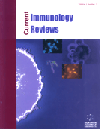- Home
- A-Z Publications
- Current Immunology Reviews (Discontinued)
- Previous Issues
- Volume 2, Issue 1, 2006
Current Immunology Reviews (Discontinued) - Volume 2, Issue 1, 2006
Volume 2, Issue 1, 2006
-
-
Editorial
More LessBy David D. LoOne of the most challenging tasks in biomedical research is keeping up with the immense literature in immunology. Recent years have shown that the traditional definition of immunology is no longer sufficient to encompass the relevant areas of study, making the task even more difficult, especially to the new investigator. Many (indeed it may be argued all) of the greatest recent advances in cellular immunology have com Read More
-
-
-
BOB.1/OBF.1 - A Critical Regulator of B Cell Function
More LessAuthors: Cornelia Brunner and Thomas WirthThe transcriptional coactivator BOB.1/OBF.1 binds as a ternary complex with the transcription factors Oct-1 and Oct-2 to DNA and induces octamer-dependent transcription. BOB.1/OBF.1 was shown to be necessary at multiple stages of B cell development, in the bone marrow as well as at late stages in secondary lymphoid organs. Bone marrow B cells from BOB.1/OBF.1-deficient mice show increased apoptosis accompanied wit Read More
-
-
-
Host Immune Responses to Aeromonas Virulence Factors
More LessAuthors: Cristi L. Galindo, Jian Sha, Amin A. Fadl, Lakshmi L. Pillai and Ashok K. ChopraAeromonas species are emerging human pathogens, which produce an array of virulence factors and cause diseases ranging from gastroenteritis to systemic infections. These bacteria can be found in food and water and grow well and produce toxins at refrigeration temperatures, which greatly increase the risk of food poisoning. A detailed understanding of host responses to Aeromonas virulence factors is paramount to Read More
-
-
-
Serotonin as a Modulator of Immune Function: An Overview
More LessThe CNS and immune system interact in a reciprocal manner through a wide variety of common mediators including neurotransmitters and cytokines. Among the former, serotonin (5-Hydroxytryptamine = 5-HT) plays a major role in the control of neuronal activity. It may also control the level of cytokines and lymphocyte proliferation. 5-HT is synthesized and released in the circulation by enterochromaffin cells from gastri Read More
-
-
-
OX40:OX40L Axis: Emerging Targets for Immunotherapy of Human Disease
More LessAuthors: Shahram Salek-Ardakani, Aihua Song, Ian R. Humphreys and Michael CroftRecent advances in our understanding of the mechanisms through which T cells are activated have led to new therapeutic approaches in the treatment of immunological disorders. An emerging target for selective immune intervention has been the manipulation of T cell costimulatory pathways. Impressive results in animal models have shown that the tumor-necrosis-factor receptor (TNFR) family member, OX40 (CD13 Read More
-
-
-
Putative Immune Regulatory Role of Statins
More LessAuthors: Hedwich F. Kuipers and Peter J. van den ElsenStatins, which are mainly used for treatment of hypercholesterolemia because of their lipid-lowering effects, may also display many immunomodulatory properties. Statins interfere in the mevalonate pathway through inhibition of HMG-CoA reductase activity and thereby affect isoprenylation of proteins and cholesterol biosynthesis. Besides lowering blood cholesterol levels, statins inhibit the production of pro-infl Read More
-
-
-
The Immunologic Barriers to Replacing Damaged Organs
More LessAuthors: Marilia Cascalho and Jeffrey L. PlattThe recent years have brought breathtaking advances in the biomedical sciences and biomedical engineering. These advances offer the promise that diseases responsible for most disability and early death may soon be addressed by replacing damaged organs with bio-engineered substitutes. Application of these technologies, however, is impeded by the immune response directed against foreign cells and tissues. Here we cons Read More
-
-
-
The Biochemical Mechanisms of T-Cell Anergy
More LessAuthors: Alexandre D. Atfield, Peter Liu and Josef M. PenningerT-cells are thought to play important roles in the coordination and development of immune responses in both health and disease. A key checkpoint in the prevention of inappropriate activation of T-cells is the requirement for costimulation by professional APCs via receptors such as CD28. Several in vivo and in vitro methods of experimental anergy induction have been developed and are in popular use today. However, the Read More
-
-
-
Sphingolipids in Cell Signaling: Their Function as Receptor Ligands, Second Messengers, and Raft Constituents
More LessAuthors: Thomas Baumruker and Andreas BillichSphingolipids have lately been recognized as important signaling molecules with an unexpected multitude of actions and mechanisms. While we are currently just uncovering the tip of the iceberg, the available data give us an unprecedented understanding of how membrane rearrangements translate into the generation of intracellular lipid signaling molecules and further into secreted bioactive lipids. Furthermore, new concep Read More
-
Volumes & issues
Most Read This Month
Article
content/journals/cir
Journal
10
5
false
en


